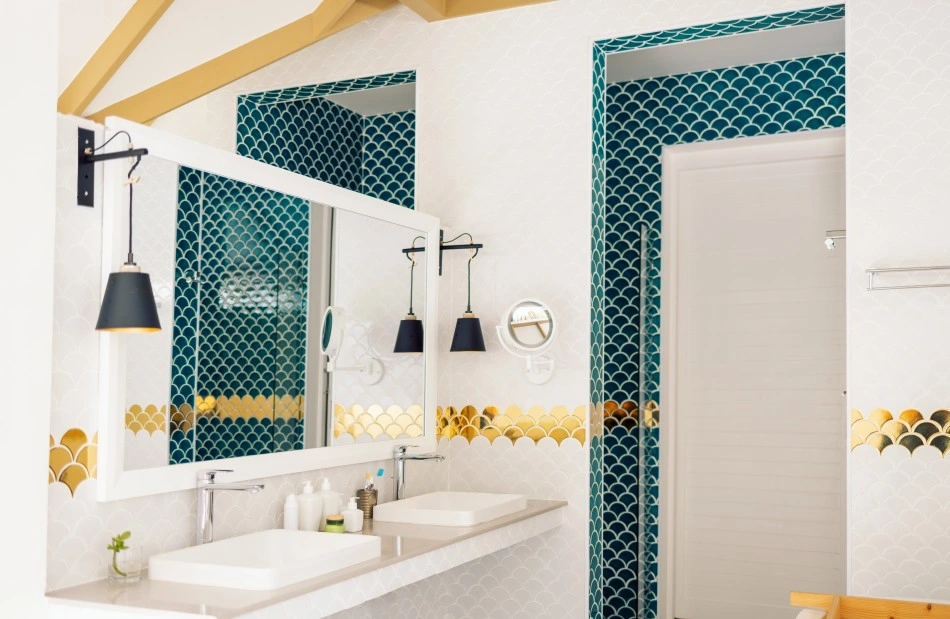A well-chosen tile can completely redefine a small bathroom—shifting it from cramped and chaotic to serene and sophisticated. When square footage is limited, visual design does a lot of heavy lifting. Through strategic use of color, pattern, shape, and layout, bathroom tile ideas serve not only to beautify but to correct spatial imbalances, helping compact spaces appear larger, brighter, and more functional.
Let’s explore how specific tile styles and arrangements can make a significant impact in a petite bathroom, providing both inspiration and guidance for homeowners ready to tackle their remodeling plans thoughtfully and with confidence.
Why Tile Choice Matters in Small Bathrooms
Small bathrooms often suffer from limited natural light, narrow floorplans, and an overwhelming accumulation of essentials. Each design decision must work overtime to bring balance, and tile is no exception. The right tile uplifts the entire room by amplifying light, creating perceived space, and introducing personal style in a way that paint or wallpaper rarely can.
When applied intelligently, bathroom tile ideas can:
- Reflect light and brighten dim spaces.
- Create continuity that makes tight spots feel more open.
- Introduce texture and color for personality without clutter.
- Highlight architectural features or create focal points.
As small bathroom renovations often involve significant costs, such as shown in this comprehensive guide, choosing the best tile early in the project ensures every dollar contributes to comfort and longevity.
Light Tiles to Brighten and Enlarge
In bathrooms where natural light is limited, tile color plays a vital role. Light-colored tiles—white, ivory, pale gray, even soft blush or sand tones—reflect more light, giving the illusion of a larger room. Glossy finishes further enhance this effect by bouncing both artificial and natural illumination.
Pair glossy white subway tiles with a matching grout for a seamless, sophisticated wall finish. For the floor, consider oversized porcelain tiles in a soft gray or beige. Larger tiles minimize grout lines, reducing visual clutter and making the room appear more continuous.
Soft hues like seafoam green or powder blue also add a hint of gentle color while maintaining a light-boosting effect. This approach complements natural materials and provides a timeless backdrop for both modern and traditional accents.
Extend Tiles from Floor to Ceiling
One of the most impactful bathroom tile ideas for small spaces is installing tiles from floor to ceiling—particularly in the shower or on the vanity wall. This creates visual height and reduces the jarring line breaks that segment a small room.
Vertical stacking elongates the walls, drawing the eye upward, while horizontal stacking widens the room. Slim rectangular tiles (such as 2×10 or 3×12 inches) laid vertically reinforce a sense of height and work beautifully in narrow bathrooms.
In walk-in showers, consider tiling not just the walls but also the ceiling in the same color. This cocoon effect subtly enlarges the shower’s dimensions and feels intentional rather than segmented.
Use Pattern Thoughtfully
Pattern can add visual interest—but when space is at a premium, it demands restraint and balance. Geometric patterns, herringbone, and chevrons are popular bathroom tile ideas that serve to highlight a feature wall or floor. These draw attention without overwhelming the entire room.
A single wall clad in encaustic patterned cement tiles, for instance, can anchor the space with color and character. Use solid-color tiles elsewhere to create visual relief.
For a subtler effect, opt for tone-on-tone patterns—a matte-and-gloss variation or a gentle ripple in glazed ceramic—offering personality while maintaining an overall cohesive look.
Choose the Right Grout Color
Grout might seem like an afterthought, but it is one of the most underrated tile design decisions, especially in tighter spaces.
Matching grout closely to tile color creates a clean and uninterrupted look, allowing the eye to focus on the surface as a whole. This works particularly well in very small bathrooms, where your objective is to avoid fragmenting the space.
For those wanting a more defined pattern or to highlight texture, using a contrasting grout color outlines each tile. For example, white subway tile paired with dark gray grout feels modern and edgy but may draw attention to every line, potentially busying a tiny room. Weigh your priorities carefully.
Opt for Diagonal or Herringbone Layouts
Diagonal tile arrangements are a long-used technique to create optical space. When floors are laid at a 45-degree angle, they trick the eye into perceiving more width, guiding focus outward.
Similarly, the herringbone pattern has become a darling in bathroom designs thanks to its movement and ability to elongate a surface. This is especially powerful in narrow bathrooms, where short walls can feel confining. Lay herringbone tiles on the floor or across the shower wall to soften box-like proportions.
These layout techniques don’t just add style—they serve the small room by subtly modifying perception.
Incorporate Niche Tiling for Functionality
When square footage is limited, wall niches are a practical blessing—and also an excellent opportunity to introduce another layer of your tile narrative. Lining recessed cubbies with a contrasting tile or mosaic adds depth and dimension, turning utilitarian features into visual gems.
Tiles with shimmering finishes, miniature mosaics, or even handmade options give these small areas a jewelry-box effect. They’re not only pleasing to the eye but also functional, keeping everyday essentials tidy.
These niches work well inside shower enclosures or above bathtubs, and they support both aesthetic and practical intent masterfully.
Consider Monochrome Tiling for Continuity
One overlooked but incredibly effective strategy? Use the same tile on walls and floors for a unified, spa-like look. Particularly in white or soft neutrals, one-material designs blur the boundaries between surfaces—this not only simplifies the view but also increases the room’s perceived size.
Stone-look porcelain or microcement-style tiles, similar to those featured in modern interior trends, offer a sleek and consistent finish with high durability. These textures honor the minimalist appeal while offering timeless longevity.
Add Warmth with Natural-Look Tiles
While white and gray dominate small bathroom tile ideas, warmth is essential to ensure the space doesn’t feel clinical. Wood-look porcelain tiles add organic texture and bring the comforting feel of natural materials without the hassle of real wood and moisture concerns.
These can be used on the floor or even as an accent wall behind a vanity mirror or freestanding tub. Pair these with concrete-effect tiles or traditional ceramics to balance the rustic with the refined.
For those who love biophilic design and natural home aesthetics, incorporating tiles with earthy undertones is a beautiful expression of that sensibility. It’s in line with popular choices seen in other parts of the home, from succulent gardens to wood-beamed ceilings.
Mirrors and Tiles: Doubling Impact
Though not technically a tile, mirrors work in tandem with tiled walls to reflect light and create dimension. When mounted directly onto tiled walls, frameless mirrors contribute to a sleek, spacious impression.
One helpful trick is to extend tile behind and beyond the mirror. This carries continuity across the wall and avoids abrupt visual breaks. For extra brilliance, mirrored or metallic-finish miniature tiles—used as border strips or within niches—introduce a sense of air and movement.
Common Pitfalls to Avoid
When evaluating bathroom tile ideas for small spaces, it's just as important to identify what to avoid:
- Overuse of dark colors: Too many rich tones can enclose a room and reduce light reflection.
- Excessive grout lines: Smaller tiles can mean more seams; use sparingly or balance with plain tiles elsewhere.
- Mixing too many patterns: Stick to one bold pattern per space. Too much variety can make a small bathroom feel busy and unbalanced.
- Glossy floors: While glossy wall tiles reflect light effectively, glossy floors can become dangerously slippery—especially in compact areas prone to splashing.
By sidestepping these missteps, you set up your renovation for both beauty and functionality.
Final Thoughts
When chosen thoughtfully, bathroom tile ideas have the power to reshape even the most limited square footage into something welcoming and refined. Whether you're layering neutral tones for a serene escape, playing with geometry for visual expansion, or using niches and layout innovations to combine form and use, tile remains one of the most flexible and expressive tools in any small space design.
Let your bathroom be a place that doesn’t just save space but makes a statement. For more inspiration on embracing smaller spaces, you might enjoy our suggestions for tall indoor plants in compact interiors and budget-friendly deck designs as complementary ways to expand how you experience your home.



